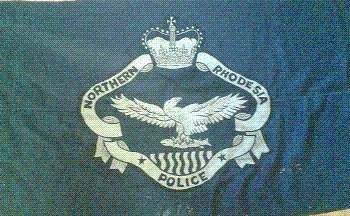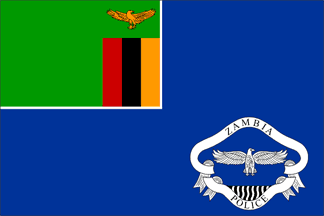 scan by
Bruce Berry, 10 Mar 2008
scan by
Bruce Berry, 10 Mar 2008
FOTW beschäftigt sich mit der Wissenschaft der Vexillologie (Flaggenkunde).
Alle auf dieser Website dargebotenen Abbildungen dienen ausschließlich der Informationsvermittlung im Sinne der Flaggenkunde.
Wir distanziert uns ausdrücklich von allen hierauf dargestellten Symbolen verfassungsfeindlicher Organisationen.
Last modified: 2015-07-28 by bruce berry
Keywords: zambia | police |
Links: FOTW homepage |
search |
disclaimer and copyright |
write us |
mirrors
 image by
Martin Grieve, 11 Mar 2008
See also:
image by
Martin Grieve, 11 Mar 2008
See also:
When Northern Rhodesia became the Republic of Zambia at independence In October 1964, the police became the Zambia Police (ZP) and made a number of changes to its badge. The basic design remains the name as its predecessor (see below) with the fish eagle and stylized Victoria Falls remaining as the central feature. The Fish Eagle no longer carries a fish in its talons. The Crown has also been removed and the new name of the force is now on the surrounding ribbon.
A new police flag was also been adopted. This contains the badge of the
ZP in the lower fly of a dark blue background with the Zambian national
flag being placed in the canton with a white fimbriation.
Bruce Berry, 11 Mar 2008
 scan by
Bruce Berry, 10 Mar 2008
scan by
Bruce Berry, 10 Mar 2008
Having no badge or seal following the establishment of the (British)
protectorate in Northern Rhodesia in April 1924, the Governor used his own seal
on official documents. In 1925 a committee was appointed to advise on an emblem
for the territory. The committee consulted the deputy leader of the Mint, the
Governor Sir Herbert Stanley, an heraldic artist at the Royal Navy base in Simonstown (near
Cape Town) and the result was a design which was adopted in
1927. The badge of the Northern Rhodesia Police had initially been a
Crested Crane, but this also appeared on the Arms of Uganda, another Colonial
Office territory and consequently the committee chose the Fish Eagle (Nkhwazi),
grasping a fish and flying over the Victoria Falls as the official emblem of the
territory. The heraldic description is "Sable six palets wavy Argent on a
Chief Azure an eagle reguardant wings expanded Or holding in the talons a Fish
of the second". The Government of the Colony accepted that this design be
used as a shield on the Public Seal of the Territory in 1927. It received the
approval of the King George V in 1930 and was formally granted to Northern
Rhodesia by Royal Warrant on 16 August 1939.
As the official emblem of the territory, the Fish Eagle also became the central
feature of the badge of the territorial police force, which also appeared on its
flag. Mr RI Hockey, of the Government Survey
Department, designed a badge for the police and this was issued in brass in
1933. After World War II, white metal was substituted for brass on buttons
and badges. Mr Martin Morris of the Livingstone Travel and Publicity Bureau
designed a chrome badge with the eagle and the fish in the centre of a roundel
bearing the name of the Force and surmounted by a Tudor Crown as the emblem of
the Northern Rhodesia Police.
The flag of the Northern Rhodesia Police had a dark blue field in the centre of
which was its badge in white. This was the fashionable shape for police
cap badges in the United Kingdom and colonies at that time. The photo
above shows an actual flag from Greg Koll's collection but with the St. Edward's
Crown. The Tudor Crown was used since the reign of King Edward VII and was
changed to the St Edward's Crown following the coronation of Queen Elizabeth II
in 1952. It is not known exactly when the flag came into use but it flew
until Northern Rhodesia became Zambia in October 1964. In terms of
Standing Order 599 the flag was flown alongside the (British) Union Flag at
Force Headquarters in Lusaka, the Police Training School at Lilayi and at the
Police Mobile Unit Headquarters at Bwana Mkubwa and later Kamfinsa. At
subordinate HQs and other police stations only the British Union Flag was flown.
Bruce Berry, 10 Mar 2008
Hosted by: Fanshop-Online.de und Handy-Shop.de
Tipp: Apple iPhone 12 im Shop